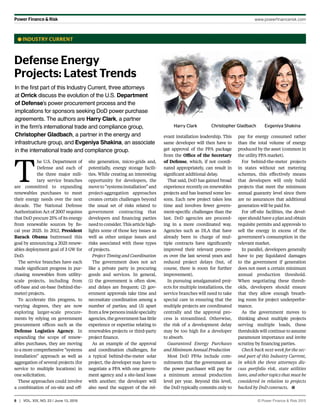
Power Finance And Risk - Defense Energy Projects - Latest Trends and Key Risk Considerations
- 1. 6 | VOL. XIX, NO. 23 / June 13, 2016 © Power Finance Risk 2015 Power Finance Risk www.powerfinancerisk.com INDUSTRY CURRENT he U.S. Department of Defense and each of the three major mili- tary service branches are committed to expanding renewables purchases to meet their energy needs over the next decade. The National Defense Authorization Act of 2007 requires that DoD procure 25% of its energy from renewable sources by fis- cal year 2025. In 2012, President Barack Obama buttressed this goal by announcing a 2025 renew- ables deployment goal of 3 GW for DoD. The service branches have each made significant progress in pur- chasing renewables from utility- scale projects, including from off-base and on-base (behind-the- meter) projects. To accelerate this progress, to varying degrees, they are now exploring larger-scale procure- ments by relying on government procurement offices such as the Defense Logistics Agency. In expanding the scope of renew- ables purchases, they are moving to a more comprehensive “systems installation” approach as well as aggregation of several projects (for service to multiple locations) in one solicitation. These approaches could involve a combination of on-site and off- site generation, micro-grids and, potentially, energy storage facili- ties. While creating an interesting opportunity for developers, the moveto“systemsinstallation”and project-aggregation approaches creates certain challenges beyond the usual set of risks related to government contracting that developers and financing parties need to consider. This article high- lights some of those key issues as well as other unique issues and risks associated with these types of projects. Project Timing and Coordination The government does not act like a private party in procuring goods and services. In general, (1) the government is often slow, and delays are frequent; (2) gov- ernment approvals take time and necessitate coordination among a number of parties; and (3) apart fromafewpersonsinsidespecialty agencies, the government has little experience or expertise relating to renewables projects or third-party project finance. As an example of the approval and coordination challenges, for a typical behind-the-meter solar project, the developer may have to negotiate a PPA with one govern- ment agency and a site-land lease with another; the developer will also need the support of the rel- Defense Energy Projects: Latest Trends In the first part of this Industry Current, three attorneys at Orrick discuss the evolution of the U.S. Department of Defense’s power procurement process and the implications for sponsors seeking DoD power purchase agreements. The authors are Harry Clark, a partner in the firm’s international trade and compliance group, Christopher Gladbach, a partner in the energy and infrastructure group, and Evgeniya Shakina, an associate in the international trade and compliance group. T Harry Clark Evgeniya ShakinaChristopher Gladbach evant installation leadership. This same developer will then have to get approval of the PPA package from the Office of the Secretary of Defense, which, if not coordi- nated appropriately, can result in significant additional delay. That said, DoD has gained broad experience recently on renewables projects and has learned some les- sons. Each new project takes less time and involves fewer govern- ment-specific challenges than the last. DoD agencies are proceed- ing in a more coordinated way. Agencies such as DLA that have already been in charge of mul- tiple contracts have significantly improved their relevant process- es over the last several years and reduced project delays (but, of course, there is room for further improvement). In pursuing amalgamated proj- ects for multiple installations, the service branches will need to take special care in ensuring that the multiple projects are coordinated centrally and the approval pro- cess is streamlined. Otherwise, the risk of a development delay may be too high for a developer to absorb. Guaranteed Energy Purchases and Minimum Annual Production Most DoD PPAs include com- mitments that the government as the power purchaser will pay for a minimum annual production level per year. Beyond this level, the DoD typically commits only to pay for energy consumed rather than the total volume of energy produced by the asset (common in the utility PPA market). For behind-the-meter projects in states without net metering schemes, this effectively means that developers will only build projects that meet the minimum annual guaranty level since there are no assurances that additional generation will be paid for. For off-site facilities, the devel- oper should have a plan and obtain requisite permits and approvals to sell the energy in excess of the government’s consumption in the relevant market. In parallel, developers generally have to pay liquidated damages to the government if generation does not meet a certain minimum annual production threshold. When negotiating these thresh- olds, developers should ensure that they allow enough breath- ing room for project underperfor- mance. As the government moves to thinking about multiple projects serving multiple loads, these thresholds will continue to assume paramount importance and invite scrutiny by financing parties. Check back next week for the sec- ond part of this Industry Current, in which the three attorneys dis- cuss portfolio risk, state utilities laws, and other topics that must be considered in relation to projects backed by DoD contracts.